The Originals Vol. 31
Volume 31 and 160 songs covered now. Here we have the originals of the Piranhas’ Tom Hark, the Rolling Stones’ It’s All Over Now, Middle of the Road’s unjustly reviled Chirpy Chirpy Cheep Cheep, Georgie Fame’s Yeh Yeh, and Donovan’s Universal Soldier (whose writer, Buffy Sainte-Marie, apparently was not the first to record it either). As always, many thanks to my friends who have helped me out with some of the songs featured here.
* * *
Elias and his Zig Zag Jive Flutes – Tom Hark (1956).mp3
The Piranhas – Tom Hark (1980).mp3
Mango Groove – Tom Hark (1996).mp3
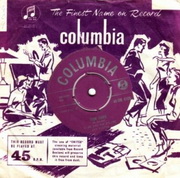 A staple these days on English football grounds, the impossibly catchy Tom Hark had its origins in South Africa. There was no Tom Hark: the song’s title was either a pun or more likely a sloppy mis-heard rendering of the word tomahawk, the axes gangs in Johannesburg’s Alexandra township used to carry.
A staple these days on English football grounds, the impossibly catchy Tom Hark had its origins in South Africa. There was no Tom Hark: the song’s title was either a pun or more likely a sloppy mis-heard rendering of the word tomahawk, the axes gangs in Johannesburg’s Alexandra township used to carry.
Composer “Big Voice” Jack Lerole and his mates used to record in the pennywhistle-based kwela genre, though it was not yet known by that name — the contemporary term was marabi or pennywhistle jive. The word kwela is Zulu for “get up”, and as kwela-kwela also a township term for a police van (after the cops’ command “Kwela! Kwela!, meaning “climb in, climb in”), the unwelcome approach of which often was signalled by a lookout blowing his tin flute. Lerole, commonly known as Jake, learnt to play the pennywhistle as a little boy, observing the flautists from Scottish regiments that often played near Alexandra and which influenced a generation of pennywhistlers who adapted the complex techniques of flute-playing to the simple pennywhistle, thereby enhancing its versatility.
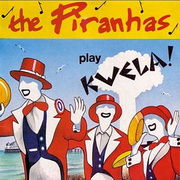 Lerole and his bandmembers recorded under several names, mostly as Alexandra Black Mambazo (mambazo is zulu for axe — or tomahawk), but were signed by EMI in 1956 as Elias and His Zig Zag Jive Flutes; the Elias of the moniker being Lerole’s brother. Having recorded Tomahawk, or Tom Hark, EMI sold the rights to the song to British TV to serve as the theme for a series called The Killing Stone. On the back of that, the song became a British hit, reaching #2 in 1958. Lerole and his band received £6 for recording the song and not a red cent in royalties, even when the song became an international hit again in 1980 with an affectionate cover by the British ska band The Piranhas, whose frontman Bob Grover put lyrics to the song (“The whole things daft, I don’t know why, you have to laugh or else you cry”). On the single cover The Piranhas paid tribute to the original by emblazoning it with the word “kwela”.
Lerole and his bandmembers recorded under several names, mostly as Alexandra Black Mambazo (mambazo is zulu for axe — or tomahawk), but were signed by EMI in 1956 as Elias and His Zig Zag Jive Flutes; the Elias of the moniker being Lerole’s brother. Having recorded Tomahawk, or Tom Hark, EMI sold the rights to the song to British TV to serve as the theme for a series called The Killing Stone. On the back of that, the song became a British hit, reaching #2 in 1958. Lerole and his band received £6 for recording the song and not a red cent in royalties, even when the song became an international hit again in 1980 with an affectionate cover by the British ska band The Piranhas, whose frontman Bob Grover put lyrics to the song (“The whole things daft, I don’t know why, you have to laugh or else you cry”). On the single cover The Piranhas paid tribute to the original by emblazoning it with the word “kwela”.
After the Alexandra Black Mambazo split in 1963, Lerole enjoyed a fair career, though more as a gravelly baritone singer and saxophonist than as a pennywhistler, having followed the lead of pennywhistle king Spokes Mashiyane into the new mbaqanga style of music. He made a comeback in the ’80s as a member of the multi-racial group Mango Groove (which recorded Tom Hark with their own lyrics), on whose first hit, Dance Some More, Lerole provided his distinctive growling vocals. Before Mango Groove became famous in South Africa, he left the group. In 1998 he and the reformed Alex Black Mambazo were invited by South African-born Dave Matthews to perform with his group in the US. The band performed to international acclaim and total indifference in their home country. Leralo died in 2003 at the age of 63.
Also recorded by: Ted Heath (1958), Millie (1964), The Talksport Allstars (as We’re England, 2006)
.
The Valentinos – It’s All Over Now (1964).mp3
The Rolling Stones – It’s All Over Now (1964).mp3
Molly Hatchet – It’s All Over Now (1979).mp3
 When the Rolling Stones arrived in the US for their first tour, they met the legendary New York radio DJ Murray the K (or Murray the Kunt, as Keith Richards would dub him), who had a heavy hand in promoting the Beatles before and during their triumphant debut tour of the US a few months earlier. Murray suggested that the group might do well to record the latest single by Cleveland’s R&B group the Valentinos, which comprised the Womack brothers Bobby, Cecil, Harry, Friendly and Curtis.
When the Rolling Stones arrived in the US for their first tour, they met the legendary New York radio DJ Murray the K (or Murray the Kunt, as Keith Richards would dub him), who had a heavy hand in promoting the Beatles before and during their triumphant debut tour of the US a few months earlier. Murray suggested that the group might do well to record the latest single by Cleveland’s R&B group the Valentinos, which comprised the Womack brothers Bobby, Cecil, Harry, Friendly and Curtis.
It’s All Over Now was written by Bobby with his sister-in-law Shirley, but the publishing rights resided with Sam Cooke’s SAR Records. The Stones’ young manager Andrew Oldham obtained the rights to record it from SAR’s manager/accountant, Allen Klein (soon to become the Stones’ despised manager). Bobby Womack was furious, correctly anticipating that the rock version by these kids from England would sabotage any chance of the Valentino’s soul single becoming a hit. He later recalled his mentor Cooke comforting him, presciently assuring him that he’d now be a part of music history by dint of having written the Rolling Stones’ first US hit. A little later Womack found another upside: when he received the first royalties cheque, “it was huge”.
Within three weeks of Murray the K turning them on to It’s all Over Now, the Stones recorded the song during their sessions at Chicago’s Chess studio (where they allegedly encountered their hero Muddy Waters painting the ceiling), which also yielded Time Is On My Side, which will feature in this series later. It was released almost immediately. The Valentino’s version tanked at #94 in the US, while the Stones reached the top 20 and went to #1 in Britain.
Also recorded by: The Chambers Brothers (1965), Ian and the Zodiacs (1965), Johnny Rivers (1965), The Pupils (1966), Waylon Jennings (1968), The Bintangs (1969), Rod Stewart (1970), Ry Cooder (1974), Faces (1974), Catfish Hodge (1975), Johnny Winter (1976), Molly Hatchet (1979), Jimmy & The Mustangs (1984), John Anderson (1985), The Dirty Dozen Brass Band (1987), Charles et les Lulus (1991), Bobby Womack (1997), Southside Johnny (1997), Paper Parrot (1999), The Alarm Clocks (2000), The Patron Saints (2008) a.o.
.
Lally Stott – Chirpy Chirpy Cheep Cheep (1970).mp3
Middle of the Road – Chirpy Chirpy Cheep Cheep (1971).mp3
 My old friend Bono likes to tell the story of how seeing Middle of the Road performing Chirpy Chirpy Cheep Cheep on Top of the Pops persuaded him that anyone, even little Paul Hewson, could become a pop star. It’s easy, even for Bono, to take a dig at a song called Chirpy Chirpy Cheep Cheep, of course. But I submit that, lyrics apart, it is a fine pop song.
My old friend Bono likes to tell the story of how seeing Middle of the Road performing Chirpy Chirpy Cheep Cheep on Top of the Pops persuaded him that anyone, even little Paul Hewson, could become a pop star. It’s easy, even for Bono, to take a dig at a song called Chirpy Chirpy Cheep Cheep, of course. But I submit that, lyrics apart, it is a fine pop song.
Middle of the Road, who thought of themselves more as a folk group than as the bubble gum pop combo they are usually remembered as, didn’t want to record the song. It had been a hit in Italy (with the subtitle Cirpi cirpi, cip cip) and Australia for its composer, Liverpudlian Lally (Harold) Stott, and even dented the US charts at #92, though the song had greater success there, reaching #20, in a version by Trinidad-born duo Mac and Katie Kissoon (the female sibling of whom later became a session singer for the likes of Van Morrison, Elton John, Eric Clapton and the Pet Shop Boys). Despite Stott’s success in Italy and Australia, his label, Philips, evidently had little confidence in the recording, so Stott farmed it out to the Middle of the Road, who had just abandoned their previous moniker, Los Caracas, to take up an engagement in Italy.
 The band recorded the song reluctantly at singer Sally Carr’s insistence. Bandleader Ken Andrews was initially dismissive: “We were as disgusted with the thought of recording it as most people were at the thought of buying it. But at the end of the day, we liked it.” Their version, produced by Giacomo Tosti, became a massive hit throughout Europe in early 1971 and was imported to Britain by holidaymakers. At first it seemed that the Kissoon’s version would be a hit there, but influential radio DJ Tony Blackburn championed the Middle of the Road version on his BBC breakfast show, and it eventually reached #1 in June ’71.
The band recorded the song reluctantly at singer Sally Carr’s insistence. Bandleader Ken Andrews was initially dismissive: “We were as disgusted with the thought of recording it as most people were at the thought of buying it. But at the end of the day, we liked it.” Their version, produced by Giacomo Tosti, became a massive hit throughout Europe in early 1971 and was imported to Britain by holidaymakers. At first it seemed that the Kissoon’s version would be a hit there, but influential radio DJ Tony Blackburn championed the Middle of the Road version on his BBC breakfast show, and it eventually reached #1 in June ’71.
Stott went on to work with Middle of the Road, writing their hit Tweedle Dee, Tweedle Dum. He died in 1977 in an accident while riding his Harley-Davidson — said to have been bought with the royalties of Chirpy Chirpy Cheep Cheep.
Also recorded by: Los 3 de Castilla (1971), Paul Mauriat (1971), Joe Harris (1971), The California Gold Rush (1971), Hajo (1971), The Jay Boys (1972), The Panda Peeple (1973), Little Angels (1973), Briard (1979), Lush (1990), Cartoons (2000), Mickie Krause (as Reiß die Hütte ab, 2003), The Poco Loco Gang (2005)
.
Mongo Santamaría – Yeh-Yeh (1963).mp3
Lambert, Hendricks & Bavan – Yeh-Yeh (1963).mp3
Georgie Fame & the Blue Flames – Yeh Yeh (1964).mp3
Matt Bianco – Yeh Yeh (1985).mp3
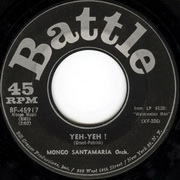 Written by jazz musicians Rodgers Grant (piano) and Laurdine “Pat” Patrick (saxophone), Yeh-Yeh was first recorded in 1963 by Afro-Cuban jazz percussionist Mongo Santamaría, whose band Grant and Patrick were members of at the time. Still an instrumental — though Santamaría’s single version includes what might be described as vocal ticks — it appeared on his Watermelon Man album. It soon came to the attention of jazz singer Jon Hendricks, one of the great purveyors of scat singing and a third of the ’50s trio Lambert, Hendricks & Ross. Hendricks had a long line of instrumental songs to which he added lyrics, doing so most famously for an album of Count Basie standards. Hendricks recorded Yeh-Yeh with the trio, in which Yalande Bavan had by now replaced Annie Ross, for the At Newport ’63 live album.
Written by jazz musicians Rodgers Grant (piano) and Laurdine “Pat” Patrick (saxophone), Yeh-Yeh was first recorded in 1963 by Afro-Cuban jazz percussionist Mongo Santamaría, whose band Grant and Patrick were members of at the time. Still an instrumental — though Santamaría’s single version includes what might be described as vocal ticks — it appeared on his Watermelon Man album. It soon came to the attention of jazz singer Jon Hendricks, one of the great purveyors of scat singing and a third of the ’50s trio Lambert, Hendricks & Ross. Hendricks had a long line of instrumental songs to which he added lyrics, doing so most famously for an album of Count Basie standards. Hendricks recorded Yeh-Yeh with the trio, in which Yalande Bavan had by now replaced Annie Ross, for the At Newport ’63 live album.
English singer Georgie Fame (his moniker was an innovation of promoter Larry Parnes who at one point even briefly renamed the yet unknown Beatles) heard the Newport recording of Lambert, Hendricks & Bavan’s version, and incorporated into his Blue Flames’ live shows. At one point in 1964 Fame and his team were stuck for a new single. Somebody suggested Yeh Yeh.
 Fames’ manager at the time was nightclub owner Ronan O’Rahilly. His attempts to have Yeh Yeh played on the BBC and Radio Luxembourg were frustrated (reportedly on grounds that it sounded “too black”; the story that it was rejected for airplay because the stations played records only from EMI, Decca, Pye and Philips can be discounted since Yeh Yeh appeared on EMI’s Columbia label). Unable to get airplay, he became part of the group that set up the ship-based pirate station Radio Caroline in March 1964. Among its roster of DJs was the champion of Chirpy Chirpy Cheep Cheep, Tony Blackburn. Radio Caroline naturally gave Yeh Yeh (which O’Rahilly has claimed directly inspired the founding of the pirate station) heavy airplay. Without help from the conventional radio stations, it topped the UK charts in January 1965 (US #25), relieving the Beatles’ five-week occupancy of the top spot with the similarly upbeat I Feel Fine.
Fames’ manager at the time was nightclub owner Ronan O’Rahilly. His attempts to have Yeh Yeh played on the BBC and Radio Luxembourg were frustrated (reportedly on grounds that it sounded “too black”; the story that it was rejected for airplay because the stations played records only from EMI, Decca, Pye and Philips can be discounted since Yeh Yeh appeared on EMI’s Columbia label). Unable to get airplay, he became part of the group that set up the ship-based pirate station Radio Caroline in March 1964. Among its roster of DJs was the champion of Chirpy Chirpy Cheep Cheep, Tony Blackburn. Radio Caroline naturally gave Yeh Yeh (which O’Rahilly has claimed directly inspired the founding of the pirate station) heavy airplay. Without help from the conventional radio stations, it topped the UK charts in January 1965 (US #25), relieving the Beatles’ five-week occupancy of the top spot with the similarly upbeat I Feel Fine.
In 1985, British jazz-popsters Matt Bianco drew together their British lounge and Latin jazz influences to record a fine version of Yeh Yeh, which strays not too far from Fame’s take. It reached #15 in the UK.
Also recorded by: Dave “Baby” Cortez (1965), Danny Fisher (1965), Claude François (as Alors salut!, 1965), Matt Bianco (1985), The Aislers Set (2000), They Might Be Giants (2001)
.
The Highwaymen – Universal Soldier (1963).mp3
Buffy Sainte-Marie – Universal Soldier (1964).mp3
Donovan – Universal Soldier (1965).mp3
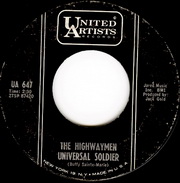 Early in the Vietnam War, Canadian folk singer Buffy Sainte-Marie saw an injured soldier return from active duty and decided to write an anti-war song. It would become one of the most potent songs in the peace movement, even if her good advice to you and me evidently has not been taken. By her own account written in a Toronto café to impress a college professor, Buffy, then in her early 20s, sold the rights to Universal Soldier to a man she had just met in Greenwich Village’s Gaslight Café, for a dollar (the contract was written on a paper napkin). Two decades later she bought the rights back for $25,000. In the interim, she made it on the White House’s blacklist for her anti-Vietnam and Native American rights activities, spent five years on Sesame Street (on which she breastfed her child), in 1966 became the first singer to release a quadraphonic album (4.0 stereo) and apparently the first to release an album on the Internet (in 1991).
Early in the Vietnam War, Canadian folk singer Buffy Sainte-Marie saw an injured soldier return from active duty and decided to write an anti-war song. It would become one of the most potent songs in the peace movement, even if her good advice to you and me evidently has not been taken. By her own account written in a Toronto café to impress a college professor, Buffy, then in her early 20s, sold the rights to Universal Soldier to a man she had just met in Greenwich Village’s Gaslight Café, for a dollar (the contract was written on a paper napkin). Two decades later she bought the rights back for $25,000. In the interim, she made it on the White House’s blacklist for her anti-Vietnam and Native American rights activities, spent five years on Sesame Street (on which she breastfed her child), in 1966 became the first singer to release a quadraphonic album (4.0 stereo) and apparently the first to release an album on the Internet (in 1991).
 Sainte-Marie released Universal Soldier on her 1964 debut album, It’s My Way. The previous year, it was recorded by folk-group The Highwaymen (not to be confused with the country supergroup), who enjoyed their commercial peak in 1960 with the hit version of Michael (Row The Boat Ashore). It’s not clear how the Highwaymen got to record Universal Soldier first; one may guess that they were given the song by Buffy’s new friend from the Gaslight Café. Released as a single and on the group’s penultimate album, March On Brothers, it was not a huge success. Of course, if one channelled Seeger and Guthrie, one did not expect to compete with the Beatles.
Sainte-Marie released Universal Soldier on her 1964 debut album, It’s My Way. The previous year, it was recorded by folk-group The Highwaymen (not to be confused with the country supergroup), who enjoyed their commercial peak in 1960 with the hit version of Michael (Row The Boat Ashore). It’s not clear how the Highwaymen got to record Universal Soldier first; one may guess that they were given the song by Buffy’s new friend from the Gaslight Café. Released as a single and on the group’s penultimate album, March On Brothers, it was not a huge success. Of course, if one channelled Seeger and Guthrie, one did not expect to compete with the Beatles.
 Acclaimed though Sainte-Marie’s debut album was, the song’s big breakthrough came with the version by Scottish folkie Donovan, who released it in 1965 at the age of 19, having already two UK Top 10 hits with Catch The Wind and Colours. Young Mr Leitch’s softer version, which adopted Buffy’s arrangement (and using strange pronunciation of the name Dachau). Released as an EP in Britain, it topped the EP charts there and reached #14 in the singles charts.
Acclaimed though Sainte-Marie’s debut album was, the song’s big breakthrough came with the version by Scottish folkie Donovan, who released it in 1965 at the age of 19, having already two UK Top 10 hits with Catch The Wind and Colours. Young Mr Leitch’s softer version, which adopted Buffy’s arrangement (and using strange pronunciation of the name Dachau). Released as an EP in Britain, it topped the EP charts there and reached #14 in the singles charts.
As for Buffy, she went on to write Up Where We Belong, the hit for Joe Cocker & Jennifer Warnes from 1981’s An Officer And A Gentleman, with then-husband Jack Nitzsche. She released her first album in 13 years, Running For The Drum, internationally a few weeks ago.
Also recorded by: Glen Campbell (1965), Boudewijn de Groot (as De eeuwige soldaat, 1965), Hector (as Palkkasoturi, 1965), Claus (as Soldato universale,1966), The Roemans (1965), The Caravans (1965), Sheila (as Je t’aime, 1966), Judy Collins and Ethel Raim Dunson (1967), Lester Flatt & Earl Scruggs (1968), Picture (1970), Juliane Werding (as Der ewige Soldat, 1973), Lobo (1974), Eugene Chadbourne (1985), Christopher Franke (1992), Eric Andersen (2004) a.o.
.



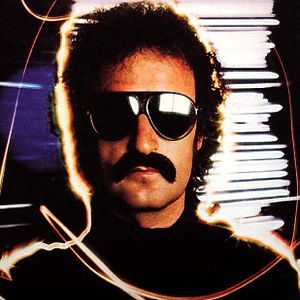 Some men, after a few razor-free weeks, might have in the process of removing the growth experimented with various temporary beard styles. First the goatee (for the geography teacher or communist icon look). Then applying razor to chin to create the Lemmy, noting with some embarrassment that our sense of symmetry is stunted when it comes to the art of barberism. So the jowlmask goes, but slowly, piece by piece, because we need to pay brief homage to the droopy ’70s porn actor look as perfected by Italian producer Giorgio Moroder (pictured). Damn symmetry again.
Some men, after a few razor-free weeks, might have in the process of removing the growth experimented with various temporary beard styles. First the goatee (for the geography teacher or communist icon look). Then applying razor to chin to create the Lemmy, noting with some embarrassment that our sense of symmetry is stunted when it comes to the art of barberism. So the jowlmask goes, but slowly, piece by piece, because we need to pay brief homage to the droopy ’70s porn actor look as perfected by Italian producer Giorgio Moroder (pictured). Damn symmetry again.
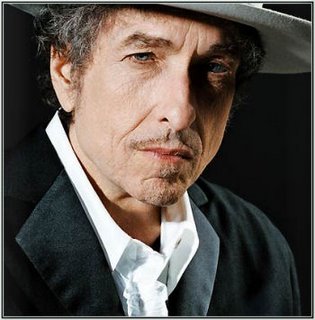


 Tony Schilder is now retired, but in his day he was a keyboard maestro in the field of South African jazz-fusion. His trio regularly featured guest artists, of whom the internationally best known is Jonathan Butler. Schilder’s trio was the houseband of the Montreal nightclub in Cape Town’s Manenberg (which lent its name, inaccurately spelt, to Dollar Brand’s jazz opus), an impoverished, gang-riddled township established by the apartheid regime for South Africans classified as “Coloured” (that is, people of mixed race). In that community’s vibrant nightclub scene, Montreal was the place to be in the 1980s. It had style and Cape Town’s great artists would regularly appear there, such as frequent Schilder collaborator Robbie Jansen (a gifted saxophonist and vocalists, whose unrecorded version of Marvin Gaye’s What’s Going On is the best I’ve heard) or Dougie Schrikker, “the Frank Sinatra of the Cape Flats”.
Tony Schilder is now retired, but in his day he was a keyboard maestro in the field of South African jazz-fusion. His trio regularly featured guest artists, of whom the internationally best known is Jonathan Butler. Schilder’s trio was the houseband of the Montreal nightclub in Cape Town’s Manenberg (which lent its name, inaccurately spelt, to Dollar Brand’s jazz opus), an impoverished, gang-riddled township established by the apartheid regime for South Africans classified as “Coloured” (that is, people of mixed race). In that community’s vibrant nightclub scene, Montreal was the place to be in the 1980s. It had style and Cape Town’s great artists would regularly appear there, such as frequent Schilder collaborator Robbie Jansen (a gifted saxophonist and vocalists, whose unrecorded version of Marvin Gaye’s What’s Going On is the best I’ve heard) or Dougie Schrikker, “the Frank Sinatra of the Cape Flats”. The famous version, of course, is that by Diana Ross, her first solo single after splitting from the Supremes. Shortly after La Ross recorded the Ashford & Simpson composition in 1970, the Supremes (now fronted by Jean Terrell) recorded it with the Four Tops, creating a more joyous version than Diana’s, which was lovely but not particularly soulful in arrangement or vocal delivery. I will be honest and admit that I had forgotten I even had this until last weekend, when I ripped most of the tracks featured here. It’s on a collection of soul tracks released in 1974 which I picked up cheaply some 20 years ago in a second-hand shop. Whatever I paid for it, this song alone made it a bargain.
The famous version, of course, is that by Diana Ross, her first solo single after splitting from the Supremes. Shortly after La Ross recorded the Ashford & Simpson composition in 1970, the Supremes (now fronted by Jean Terrell) recorded it with the Four Tops, creating a more joyous version than Diana’s, which was lovely but not particularly soulful in arrangement or vocal delivery. I will be honest and admit that I had forgotten I even had this until last weekend, when I ripped most of the tracks featured here. It’s on a collection of soul tracks released in 1974 which I picked up cheaply some 20 years ago in a second-hand shop. Whatever I paid for it, this song alone made it a bargain. American readers of a certain age may well remember this: Hushabye was the song with which the legendary DJ Alan Freed closed his televised Big Beat Show. Written by Doc Pomus and Mort Shuman, it was released in 1959 by the New York doo wop group The Mystics, Italian-Americans from Bensonhurst. A year after Hushabye was released, a young Paul Simon (then calling himself Jerry Landis) joined as lead singer, albeit only very briefly.
American readers of a certain age may well remember this: Hushabye was the song with which the legendary DJ Alan Freed closed his televised Big Beat Show. Written by Doc Pomus and Mort Shuman, it was released in 1959 by the New York doo wop group The Mystics, Italian-Americans from Bensonhurst. A year after Hushabye was released, a young Paul Simon (then calling himself Jerry Landis) joined as lead singer, albeit only very briefly. Jazz legends The Crusaders covered Carole King’s So Far Away twice. The studio version is nice; the live take, from 1974’s Scratch: Live At The Roxy, is brilliant. It’s warm and cool, exciting and relaxing. And it sounds barely like the original tune. At 1:54 trombonist Wayne Henderson begins a note which he holds continuously for a minute, driving the crowd mad with concern for his safety (one member shouts “stop!”) before Sample, Hooper, Felder, Carlton and Popwell resume to finish the song off in a rhapsodic orgasm.
Jazz legends The Crusaders covered Carole King’s So Far Away twice. The studio version is nice; the live take, from 1974’s Scratch: Live At The Roxy, is brilliant. It’s warm and cool, exciting and relaxing. And it sounds barely like the original tune. At 1:54 trombonist Wayne Henderson begins a note which he holds continuously for a minute, driving the crowd mad with concern for his safety (one member shouts “stop!”) before Sample, Hooper, Felder, Carlton and Popwell resume to finish the song off in a rhapsodic orgasm.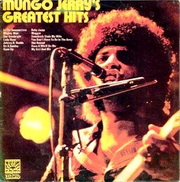 A typically exuberant Mungo Jerry number with its boogie woogie piano, improvised instrument, percussive oral noises and Ray Dorset’s obligatory scat and exclamation of “all right, all right, all right”. Most of Mungo Jerry’s tracks sounded like they were remakes of old songs, but few actually were. Have A Whiff On Me is an exception; it was an old blues song which the folk/blues historians John and Alan Lomax picked up from James “Ironhead” Baker (he of
A typically exuberant Mungo Jerry number with its boogie woogie piano, improvised instrument, percussive oral noises and Ray Dorset’s obligatory scat and exclamation of “all right, all right, all right”. Most of Mungo Jerry’s tracks sounded like they were remakes of old songs, but few actually were. Have A Whiff On Me is an exception; it was an old blues song which the folk/blues historians John and Alan Lomax picked up from James “Ironhead” Baker (he of  The regular reader will have noticed that this blog features very little by way of reggae (one Peter Tosh track, and one by Freddie McGregor in 321 posts). For a brief time in the mid-‘80s I was into reggae, absorbed a lot of it, and then got bored with it. During that fleeting flirtation, I bought the 12” of Own Them Control Them by the London band Misty In Roots. It was not a hit – none of the group’s single bothered the UK Top 75 – and I hadn’t heard it for a very long time. When I did, it did remind me why I bought the record in first place: it’s very good indeed.
The regular reader will have noticed that this blog features very little by way of reggae (one Peter Tosh track, and one by Freddie McGregor in 321 posts). For a brief time in the mid-‘80s I was into reggae, absorbed a lot of it, and then got bored with it. During that fleeting flirtation, I bought the 12” of Own Them Control Them by the London band Misty In Roots. It was not a hit – none of the group’s single bothered the UK Top 75 – and I hadn’t heard it for a very long time. When I did, it did remind me why I bought the record in first place: it’s very good indeed. Before Disney had their massive resurgence following 1989’s A Little Mermaid, the studio had lost its mojo It took Universal with the Steven Spielberg produced An American Tail in 1986 to show Disney the way to make great animated films again (even if some of them were too saccharine for my taste). The adventures of the immigrant mouse Fievel were charming, certainly in the first film. Children in film can be very endearing or very annoying. Phillip Glasser, barely eight-years-old at the time, voiced Fievel beautifully. His reprimand to Plummer’s French Statue-of-Liberty-building pidgeon for using the word “never” is very cute without being too sugary.
Before Disney had their massive resurgence following 1989’s A Little Mermaid, the studio had lost its mojo It took Universal with the Steven Spielberg produced An American Tail in 1986 to show Disney the way to make great animated films again (even if some of them were too saccharine for my taste). The adventures of the immigrant mouse Fievel were charming, certainly in the first film. Children in film can be very endearing or very annoying. Phillip Glasser, barely eight-years-old at the time, voiced Fievel beautifully. His reprimand to Plummer’s French Statue-of-Liberty-building pidgeon for using the word “never” is very cute without being too sugary. We started with a bit of South African music, and here we wrap up with the greatest ever South African song which in a truncated form and combined in a medley with the old apartheid-era anthem Die Stem is part of South Africa’s current national anthem. To this day, I refuse to sing the apartheid-anthem portion, an act of recalcitrance which many South Africans with much greater grievances than I can lay claim to evidently do not share, for they sing it with gusto.
We started with a bit of South African music, and here we wrap up with the greatest ever South African song which in a truncated form and combined in a medley with the old apartheid-era anthem Die Stem is part of South Africa’s current national anthem. To this day, I refuse to sing the apartheid-anthem portion, an act of recalcitrance which many South Africans with much greater grievances than I can lay claim to evidently do not share, for they sing it with gusto.
 The Hollies’ guitarist Tony Hicks was desperately looking for a song to record when he was played a demo of He Ain’t Heavy, He’s My Brother. The band decided to record it without great expectations, with Reg Dwight (who would become Elton John) on piano. Of course, it became a mega-hit and pop classic. But the Hollies were not the first to record it. The song had already been released by Kelly Gordon in April 1969 — five months before the Hollies’ version — as a single and on his Defunked album (the single’s b-side was That’s Life, a song Gordon had co-written five years earlier, but had been recorded before and made famous by Frank Sinatra). The original of He Ain’t Heavy by Gordon, more active as a producer than a singer, is slower and more mournful. Based on his interpretation, the publishers thought it would be a good song for Joe Cocker to record. And it would have been, but Cocker turned the song down.
The Hollies’ guitarist Tony Hicks was desperately looking for a song to record when he was played a demo of He Ain’t Heavy, He’s My Brother. The band decided to record it without great expectations, with Reg Dwight (who would become Elton John) on piano. Of course, it became a mega-hit and pop classic. But the Hollies were not the first to record it. The song had already been released by Kelly Gordon in April 1969 — five months before the Hollies’ version — as a single and on his Defunked album (the single’s b-side was That’s Life, a song Gordon had co-written five years earlier, but had been recorded before and made famous by Frank Sinatra). The original of He Ain’t Heavy by Gordon, more active as a producer than a singer, is slower and more mournful. Based on his interpretation, the publishers thought it would be a good song for Joe Cocker to record. And it would have been, but Cocker turned the song down. There have been many covers of the song. I have several favourites. Donny Hathaway’s soul interpretation tops the Hollies’ pop version. Then there are two fine a cappella versions. There are three such recordings by the Housemartins are in circulation: on the compilation Now That’s What I Call Quite Good, as a bonus track on the London 0 Hull 4 CD, and unofficially on the 1986 BBC Saturday Live sessions. It is the latter featured here. It might very well have been inspired by the magnificent version released in 1971 by the a cappella band The Persuasions, who recorded it as part of a medley with You’ve Got A Friend — which the Housemartins also recorded a cappella. (Edit: See the message by former Persuasions frontman Jerry Lawson in the comments section.)
There have been many covers of the song. I have several favourites. Donny Hathaway’s soul interpretation tops the Hollies’ pop version. Then there are two fine a cappella versions. There are three such recordings by the Housemartins are in circulation: on the compilation Now That’s What I Call Quite Good, as a bonus track on the London 0 Hull 4 CD, and unofficially on the 1986 BBC Saturday Live sessions. It is the latter featured here. It might very well have been inspired by the magnificent version released in 1971 by the a cappella band The Persuasions, who recorded it as part of a medley with You’ve Got A Friend — which the Housemartins also recorded a cappella. (Edit: See the message by former Persuasions frontman Jerry Lawson in the comments section.) (Text has been edited since it was first posted)
(Text has been edited since it was first posted)  Although Lieberman didn’t score a big hit with the song, Flack stumbled upon it in 1972 while in air. After reading about Lieberman in the TWA airline magazine and her interest piqued by the title of the song, she tuned into the song on the in-flight radio, and decided to record it herself. Over a period of three months, Flack experimented with and rearranged the song, changing the chord structure, adding the soaring ad libs and ending the song on a major chord where Lieberman did with a minor. Her remake made an immediate impression, topping the US charts for four weeks and reaching #6 in Britain. Her version won Grammys for Song of the Year, Record of the Year and Best Pop Vocal Performance.
Although Lieberman didn’t score a big hit with the song, Flack stumbled upon it in 1972 while in air. After reading about Lieberman in the TWA airline magazine and her interest piqued by the title of the song, she tuned into the song on the in-flight radio, and decided to record it herself. Over a period of three months, Flack experimented with and rearranged the song, changing the chord structure, adding the soaring ad libs and ending the song on a major chord where Lieberman did with a minor. Her remake made an immediate impression, topping the US charts for four weeks and reaching #6 in Britain. Her version won Grammys for Song of the Year, Record of the Year and Best Pop Vocal Performance. Riders In The Sky, sometimes known as Ghost Riders In The Sky, is one of those standards which is famous mostly for being famous. It has been recorded many times, and most people know at least its melody (I knew it first in the The Ventures’ 1961 guitar-driven instrumental version), but there seems to be no artist to whom the song is universally and specifically attached.
Riders In The Sky, sometimes known as Ghost Riders In The Sky, is one of those standards which is famous mostly for being famous. It has been recorded many times, and most people know at least its melody (I knew it first in the The Ventures’ 1961 guitar-driven instrumental version), but there seems to be no artist to whom the song is universally and specifically attached.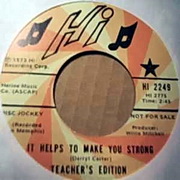 For a prolific songwriter, Elvis Costello has covered songs widely. His best known cover perhaps is George Jones’ A Good Year For The Roses, itself a country classic. I Wanna Be Loved, a Costello single in 1984 which appeared on the otherwise underwhelming Goodbye Cruel World album (and features Scritti Politti’s Green Gartside on backing vocals), was plucked from obscurity. That’s what Costello said, and he was not exaggerating. I have been able to find nothing about Teacher’s Edition or about Farnell Jenkins, who wrote the song, except that it was released in on the Memphis-based Hi Records (which counted Al Green, Ann Peebles and O.V. Wright among its roster) in1973 as a b-side to a song titled It Helps To Make You Strong, and enjoyed popularity in the Northern Soul set. Jenkins, now 67, now seems to be a Chicago-based writer of Gospel songs.
For a prolific songwriter, Elvis Costello has covered songs widely. His best known cover perhaps is George Jones’ A Good Year For The Roses, itself a country classic. I Wanna Be Loved, a Costello single in 1984 which appeared on the otherwise underwhelming Goodbye Cruel World album (and features Scritti Politti’s Green Gartside on backing vocals), was plucked from obscurity. That’s what Costello said, and he was not exaggerating. I have been able to find nothing about Teacher’s Edition or about Farnell Jenkins, who wrote the song, except that it was released in on the Memphis-based Hi Records (which counted Al Green, Ann Peebles and O.V. Wright among its roster) in1973 as a b-side to a song titled It Helps To Make You Strong, and enjoyed popularity in the Northern Soul set. Jenkins, now 67, now seems to be a Chicago-based writer of Gospel songs.
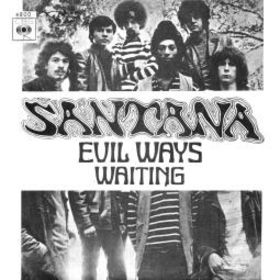 The vocals (and the organ solo) on the Santana version are by the band’s co-founder Gregg Rolie, whose keyboards and vocals were also so integral to Santana’s version of Black Magic Woman (featured in Vol. 1). Rolie proceeded to co-found Journey with former Santana bandmate Neal Schon. In Journey, Rolie was initially lead vocalist, but ceded frontman duties when Steve Perry joined.
The vocals (and the organ solo) on the Santana version are by the band’s co-founder Gregg Rolie, whose keyboards and vocals were also so integral to Santana’s version of Black Magic Woman (featured in Vol. 1). Rolie proceeded to co-found Journey with former Santana bandmate Neal Schon. In Journey, Rolie was initially lead vocalist, but ceded frontman duties when Steve Perry joined.

Recent Comments